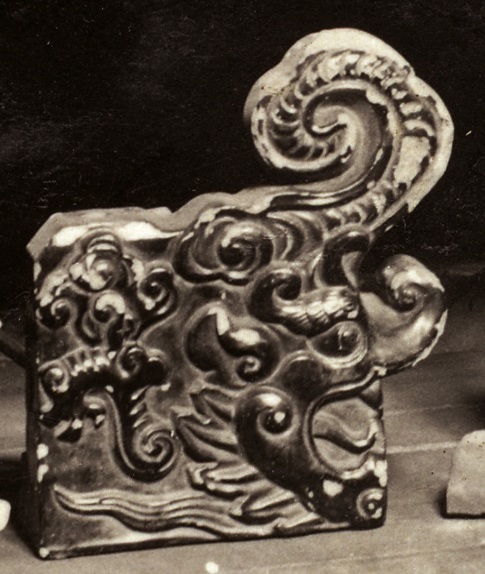Provenance: China, Qing Dynasty, Kangxi period (1662-1722) or Qianlong (1736-1795).
Workshop: unknown, probably from the vicinity of Beijing (Beijing)
Architectural detail; burnt clay; die imprinting, manual processing, glazing possibly green, firing several times
Dimensions: unknown, presumably approx. 30 cm high (data based on comparison with artifacts from the collection of the Museum für Ostasiatische Kunst in Cologne).
Signatures, inscriptions – none
Pre-war inv. No. – unknown
Date of loss of the work: 1945
Current place of storage, inv. – unknown
Most likely, this element could also come from the gift of the Chinese prince regent donated to the Malbork collection in 1908 by Major Reinhold Khlemet.
It was one of the two segments of the end of the roof ridge, which together formed the preader – the equivalent of the European acroterion. The box-shaped structure of the segment was plastically developed on both sides in the form of a dragon with a scaly torso coiled in a volute and placed just above the head like a horn, and with five-clawed paws placed behind its head. Above it, in the upper wall of the structure, there was a hole to put on another segment with another paw with claws. The head of a dragon with an open mouth with a tongue and a horn on the nose wrapped in a scroll was the largest and most expressive element of the entire composition. There was a round mounting hole in the dragon’s mouth, connecting this element with other tiles or decorations on the ridge. In the oblique cut wall at the back of the segment, there was the main mounting hole with which it was possible to connect both identical segments in the so-called the owl’s tail (Chinese hejiaowen) on the hip roof reader.
Iconography: dragon – in Chinese mythology it is primarily a symbol of the emperor and the male element (Chinese yang). In Chinese mythology, green is primarily a symbol of life and spring (see Wolfram Eberhard, Chinese symbols, Kraków 1998, pp. 234–237, 302–303).
In the Malbork collection, apart from the segment described above, there were two more, younger ones, arranged quite schematically, in a very similar way to those in the collection of the Museum of East Asian Art in Cologne, and dating back to the turn of the 19th century (see: Jiena Huo, Weisses Gold. Porzellan und Baukeramik aus China 1400 bis 1900, Köln 2015, pp. 234–237 [cat. 94]).
(compiled by Dr. B. Pospieszna)

